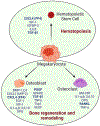Megakaryocyte Secreted Factors Regulate Bone Marrow Niche Cells During Skeletal Homeostasis, Aging, and Disease
- PMID: 37243755
- PMCID: PMC11179715
- DOI: 10.1007/s00223-023-01095-y
Megakaryocyte Secreted Factors Regulate Bone Marrow Niche Cells During Skeletal Homeostasis, Aging, and Disease
Abstract
The bone marrow microenvironment contains a diverse array of cell types under extensive regulatory control and provides for a novel and complex mechanism for bone regulation. Megakaryocytes (MKs) are one such cell type that potentially acts as a master regulator of the bone marrow microenvironment due to its effects on hematopoiesis, osteoblastogenesis, and osteoclastogenesis. While several of these processes are induced/inhibited through MK secreted factors, others are primarily regulated by direct cell-cell contact. Notably, the regulatory effects that MKs exert on these different cell populations has been found to change with aging and disease states. Overall, MKs are a critical component of the bone marrow that should be considered when examining regulation of the skeletal microenvironment. An increased understanding of the role of MKs in these physiological processes may provide insight into novel therapies that can be used to target specific pathways important in hematopoietic and skeletal disorders.
Keywords: Bone mass; Hematopoiesis; Megakaryocyte; Osteoblast; Osteoclast.
© 2023. The Author(s), under exclusive licence to Springer Science+Business Media, LLC, part of Springer Nature.
Conflict of interest statement
Statements and Declarations/Disclosure Statement
Sonali J. Karnik, Murad K. Nazzal, Melissa A. Kacena, and Angela Bruzzaniti declare that they have no competing interests to declare that are relevant to the content of this article.
Figures


Similar articles
-
S100 Calcium-Binding Protein P Secreted from Megakaryocytes Promotes Osteoclast Maturation.Int J Mol Sci. 2021 Jun 7;22(11):6129. doi: 10.3390/ijms22116129. Int J Mol Sci. 2021. PMID: 34200172 Free PMC article.
-
The bone marrow niche from the inside out: how megakaryocytes are shaped by and shape hematopoiesis.Blood. 2022 Jan 27;139(4):483-491. doi: 10.1182/blood.2021012827. Blood. 2022. PMID: 34587234 Free PMC article. Review.
-
Identification of megakaryocytes as a target of advanced glycation end products in diabetic complications in bone marrow.Acta Diabetol. 2018 May;55(5):419-427. doi: 10.1007/s00592-018-1109-z. Epub 2018 Feb 8. Acta Diabetol. 2018. PMID: 29417230
-
OP9 bone marrow stroma cells differentiate into megakaryocytes and platelets.PLoS One. 2013;8(3):e58123. doi: 10.1371/journal.pone.0058123. Epub 2013 Mar 1. PLoS One. 2013. PMID: 23469264 Free PMC article.
-
Megakaryocytes as the Regulator of the Hematopoietic Vascular Niche.Front Oncol. 2022 Jun 22;12:912060. doi: 10.3389/fonc.2022.912060. eCollection 2022. Front Oncol. 2022. PMID: 35814384 Free PMC article. Review.
Cited by
-
Temporal bone marrow of the rat and its connections to the inner ear.Front Neurol. 2024 May 16;15:1386654. doi: 10.3389/fneur.2024.1386654. eCollection 2024. Front Neurol. 2024. PMID: 38817550 Free PMC article.
-
The Skeleton as a Secretory Organ.Calcif Tissue Int. 2023 Jul;113(1):1-3. doi: 10.1007/s00223-023-01106-y. Epub 2023 Jul 1. Calcif Tissue Int. 2023. PMID: 37393315 No abstract available.
-
Do Not Lose Your Nerve, Be Callus: Insights Into Neural Regulation of Fracture Healing.Curr Osteoporos Rep. 2024 Feb;22(1):182-192. doi: 10.1007/s11914-023-00850-2. Epub 2024 Jan 31. Curr Osteoporos Rep. 2024. PMID: 38294715 Free PMC article. Review.
-
The effects of young and aged, male and female megakaryocyte conditioned media on angiogenic properties of endothelial cells.Aging (Albany NY). 2024 Nov 22;16(21):13181-13200. doi: 10.18632/aging.206077. Epub 2024 Nov 22. Aging (Albany NY). 2024. PMID: 39578050 Free PMC article.
-
Role of the Neurologic System in Fracture Healing: An Extensive Review.Curr Osteoporos Rep. 2024 Feb;22(1):205-216. doi: 10.1007/s11914-023-00844-0. Epub 2024 Jan 18. Curr Osteoporos Rep. 2024. PMID: 38236509 Free PMC article. Review.
References
-
- Taichman RS (2005) Blood and bone: two tissues whose fates are intertwined to create the hematopoietic stem-cell niche. Blood 105(7):2631–2639 - PubMed
Publication types
MeSH terms
Grants and funding
LinkOut - more resources
Full Text Sources

